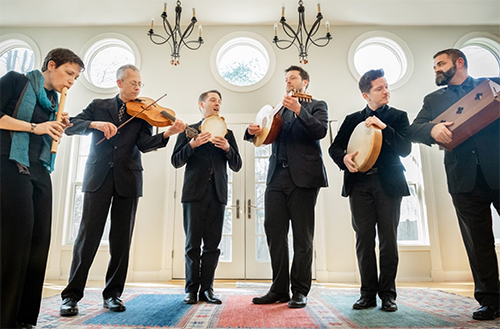by Daniel Hathaway

On Sunday, January 19 in Herr Chapel of Plymouth Church, countertenor Martin Near, tenor Jason McStoots, and baritone Sumner Thompson formed various combinations with instrumentalists Mark Rimple, Debra Nagy, and Scott Metcalfe. The 75-minute program featured music by Machaut, Galiot, Solage, Matteo da Perugia, and Pierre de Molins — along with several pieces by that shy but prolific Medieval composer Anonymous and arrangements and elaborations by Nagy. From time to time, Nagy and Metcalfe doubled on harp, and Rimple and Nagy on voice.
The music of Machaut and his contemporaries is a special, rarefied repertoire that observes its own rules of harmony and texture. Some of the works heard on Sunday, as Scott Metcalfe writes in his excellent program notes,
are made in the rhythmically complex style that was enabled by refinements in musical notation developed in the latter part of the fourteenth century. The best music in this style, later dubbed the Ars subtilior (the more subtle art) is jazzy, at once hard to grasp and intoxicating: its complicated rhythms are precisely specified but the effect is loose, improvisatory, and spellbinding.
Highlights of the afternoon were many, but Jason McStoots’ engaged and expressive solos in Machaut’s Je vivroie liement and the Anonymous Esperance qui en mon cuer s’embat stood out, as did Nagy’s virtuosic recorder playing in Matteo da Perugia’s Andray soulet and her attractively buzzy contributions to several works on the douçaine. Late in the program, Mark Rimple’s striking lute solo in Pierre de Molins’ De ce que foul pense from the Faenza codex turned heads.
The program began and ended with pieces blending voices and instruments — the Anonymous Je languis d’amere mort and Machaut’s lovely Rose, liz, printemps verdure, both testaments to the versatility and musicality of the performers.
Given the wealth of period illustrations available, projections would have been a welcome feature of this performance, not only for historical context and to create a narrative, but also to facilitate following along with the texts. But the opportunity to visit expert performances of the music of such a unique period in history was extremely rewarding, and held one’s attention from beginning to end.
Published on ClevelandClassical.com January 21, 2020.
Click here for a printable copy of this article



